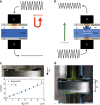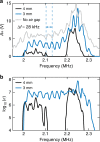Acoustic radiation pressure for nonreciprocal transmission and switch effects
- PMID: 31337755
- PMCID: PMC6650405
- DOI: 10.1038/s41467-019-11305-7
Acoustic radiation pressure for nonreciprocal transmission and switch effects
Abstract
Systems capable of breaking wave transmission reciprocity have recently led to tremendous developments in wave physics. We report herein on a concept that enables one-way transmission of ultrasounds, an acoustic diode, by relying on the radiation pressure effect. This effect makes it possible to reconfigure a multilayer system by significantly deforming a water-air interface. Such a reconfiguration is then used to achieve an efficient acoustic transmission in a specified direction of propagation but not in the opposite, hence resulting in a highly nonreciprocal transmission. The corresponding concept is experimentally demonstrated using an aluminum-water-air-aluminum multilayer system, providing the means to overcome key limitations of current nonreciprocal acoustic devices. We also demonstrate that this diode functionality can even be extended to the design and operations of an acoustic switch, thus paving the way for new wave control possibilities, such as those based on acoustic transistors, phonon computing and amplitude-dependent filters.
Conflict of interest statement
The authors declare no competing interests.
Figures




References
-
- Jalas D, et al. What is—and what is not—an optical isolator. Nat. Photonics. 2013;7:579–582. doi: 10.1038/nphoton.2013.185. - DOI
-
- Gallo, K., Assanto, G., Parameswaran, K. R. & Fejer, M. M. All-optical diode in a periodically poled lithium niobate waveguide. Appl. Phys. Lett. 79, 314-3 (2001).
-
- Estep NA, Sounas DL, Soric J, Alu A. Magnetic-free non-reciprocity and isolation based on parametrically modulated coupled-resonator loops. Nat. Phys. 2014;10:923–927. doi: 10.1038/nphys3134. - DOI
LinkOut - more resources
Full Text Sources
Other Literature Sources

